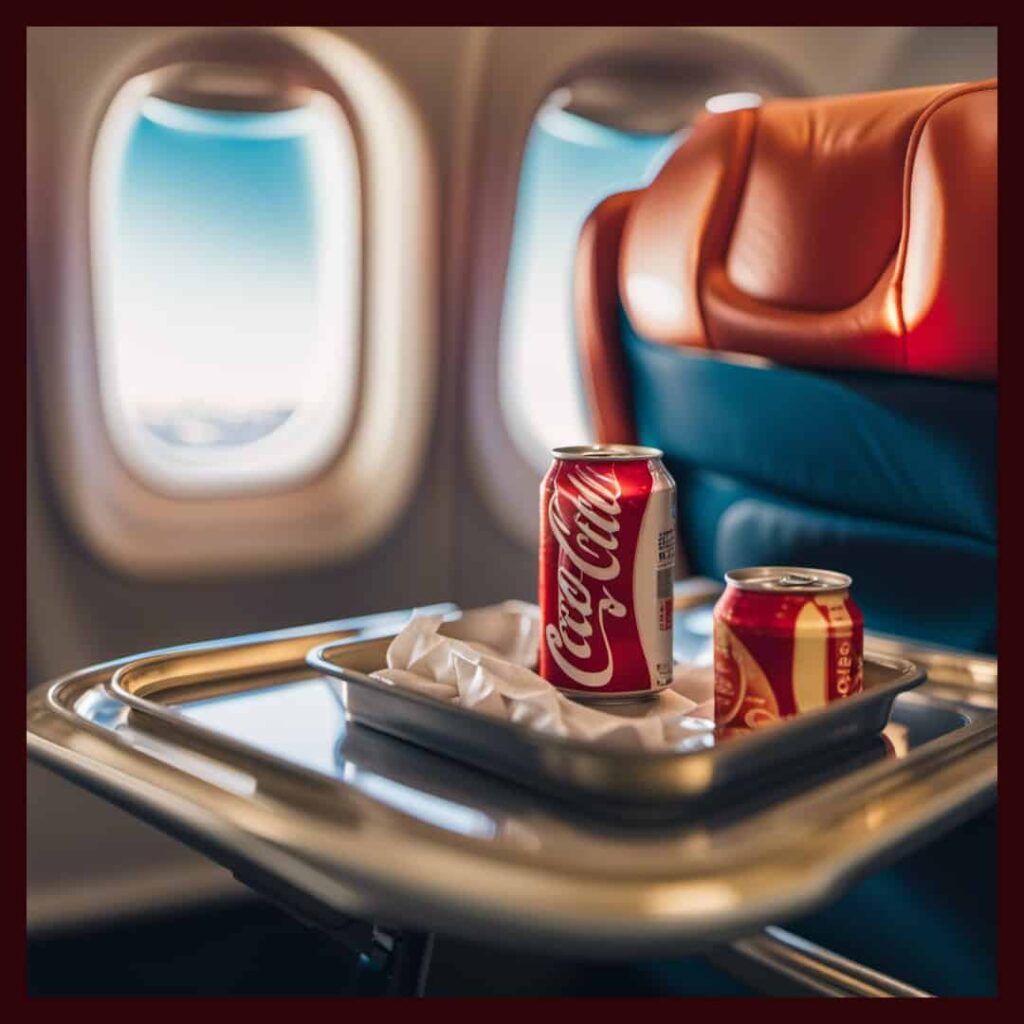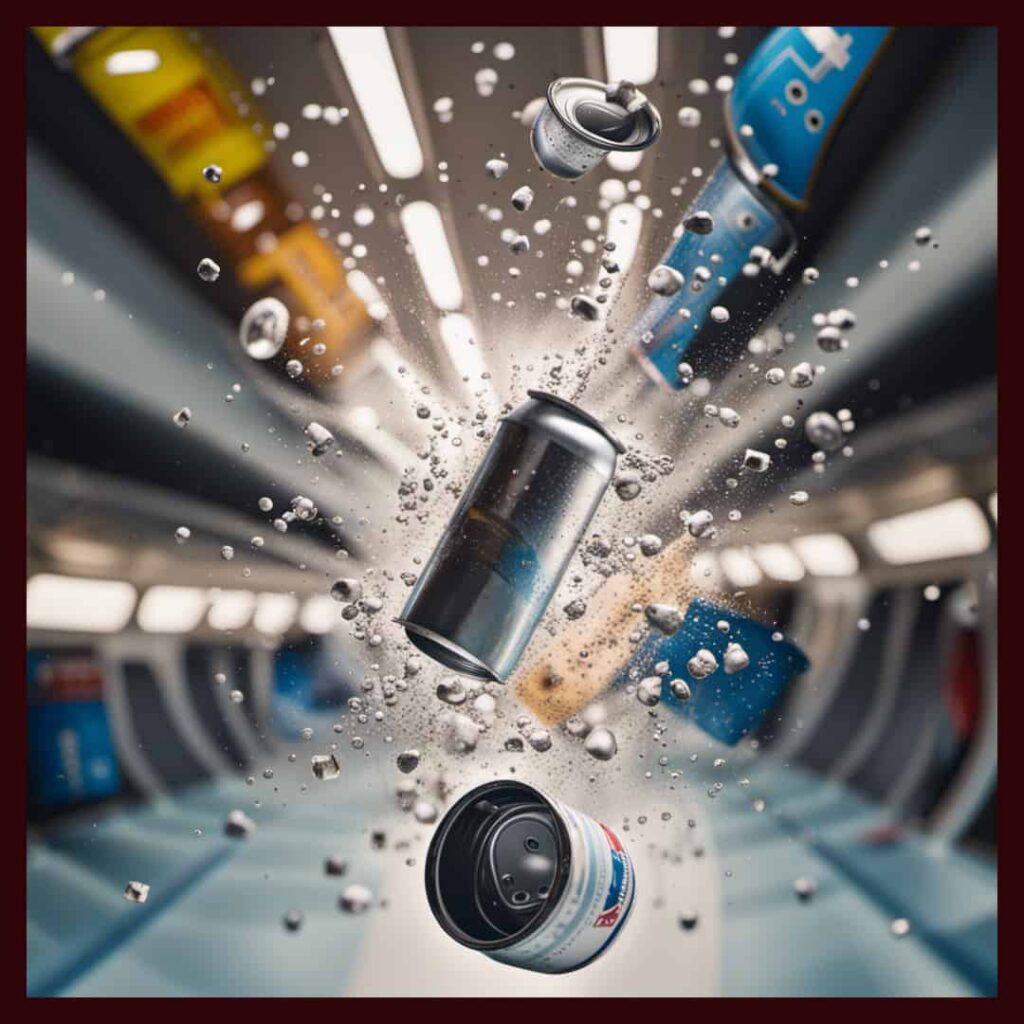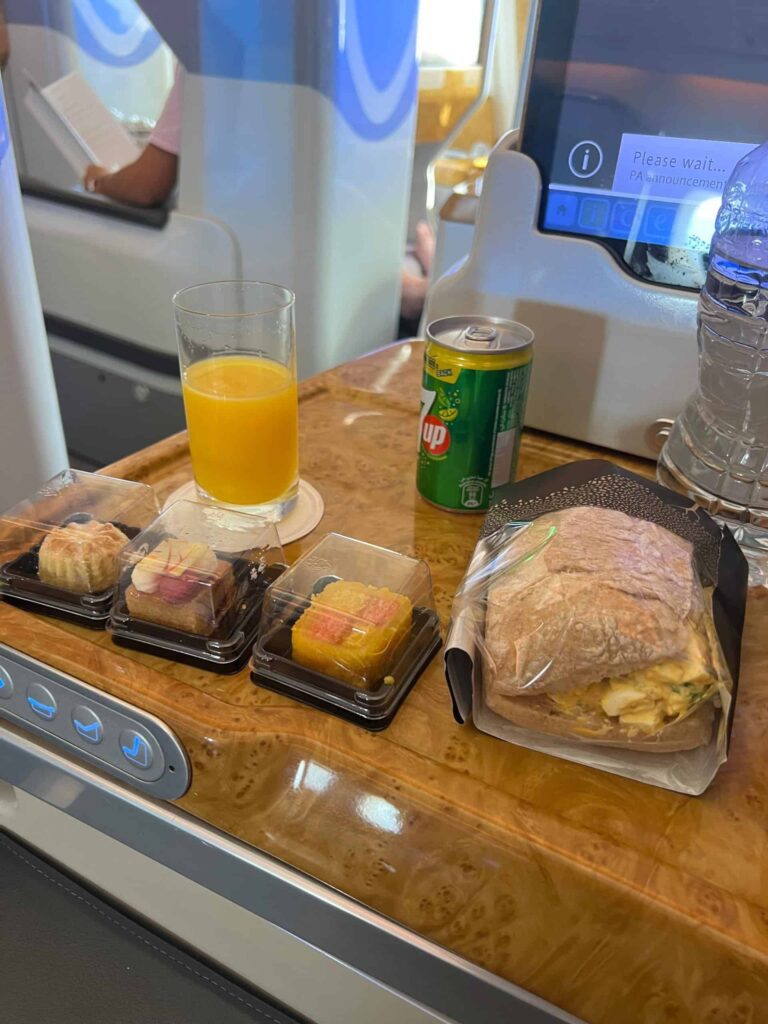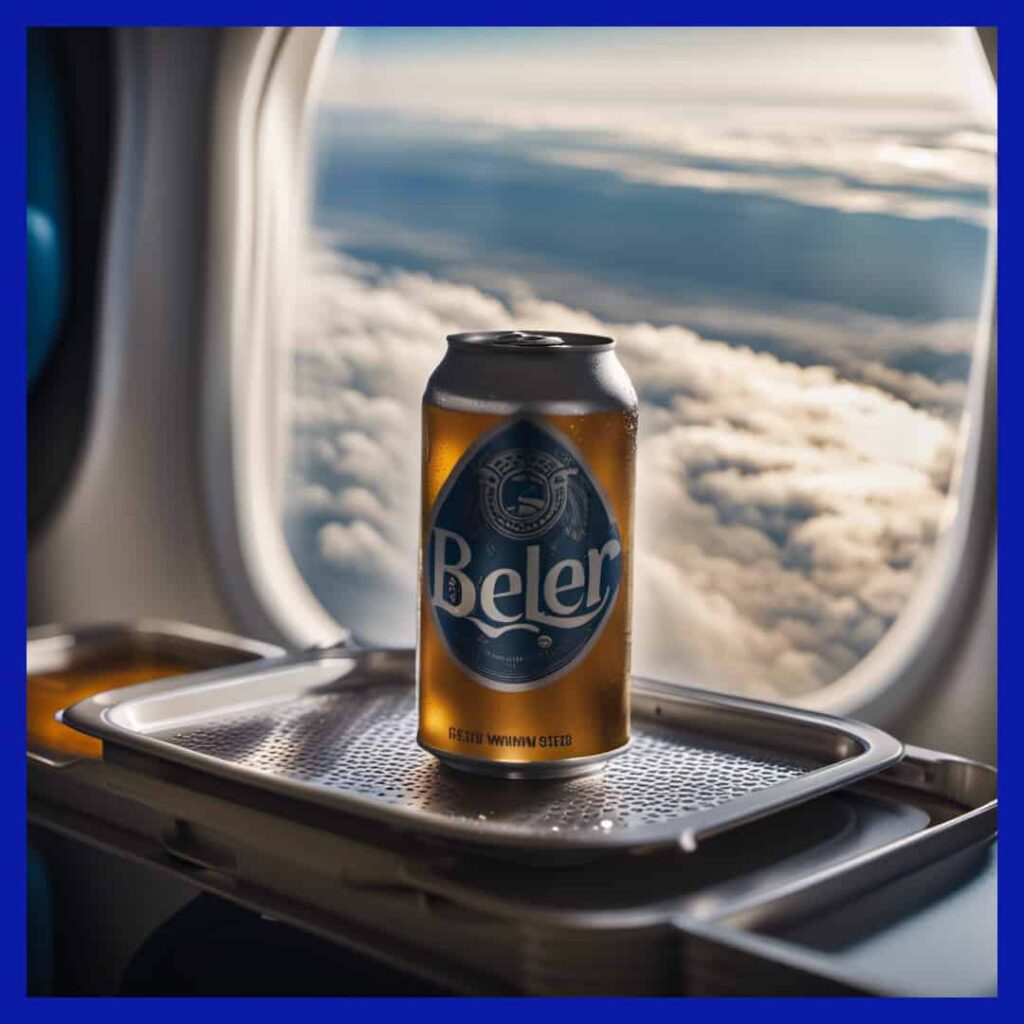Traveling with soda cans on a plane often raises concerns about whether they might explode due to changes in air pressure or other factors during the flight. Passengers might worry that packing a carbonated beverage in their luggage could cause a messy and inconvenient situation.
Contrary to popular belief, carbonated drinks like soda generally do not explode while on a plane, whether they are in the cabin or the cargo hold.
However, it is still important to be aware of airline restrictions and take certain precautions when packing soda cans in your luggage to avoid potential issues.
When packing soda cans in your checked baggage, it is a good idea to wrap them in bubble wrap or another form of protection.
This can help minimize the risk of damage from baggage handlers or other sources. Ensuring that your soda cans are properly secured and within airline guidelines will make for a smooth and worry-free experience when traveling by air.

Understanding Pressure and Soda Cans on Planes
Air pressure changes with altitude, leading to concerns about soda cans exploding on planes. Aircraft cabins are typically pressurized, preventing significant pressure changes.
Soda cans are considered durable enough to withstand normal pressure changes during a flight. As a result, they are unlikely to explode or leak in an airplane’s cargo hold.
Due to the limited changes in air pressure, soda cans that passengers bring onto airplanes remain generally safe and intact. As a precaution, it’s still a good idea to be careful when opening cans, as they might be slightly fizzier than usual.
Aircraft cargo holds are also typically temperature-controlled to ensure that items, such as soda cans and carbonated beverages, do not suffer damage due to extreme heat or cold. This is another factor that helps prevent the possibility of soda cans exploding during flights.
In summary, while unlikely, it is essential to know that air pressure changes can potentially cause soda cans to leak or spray a small amount of liquid onto surrounding cargo. Thankfully, the pressurized and temperature-controlled environment of the aircraft significantly minimizes this risk.

Carrying Soda Cans in Luggage
Soda cans can be packed in both checked and hand luggage. It is important to note the Transportation Security Administration (TSA) liquid rules for hand luggage.
Cabin pressure changes might cause soda cans to explode, but it is not very likely. This is due to rigorous airport security measures.
When packing soda cans in checked bags, make sure to use proper packaging materials. This will prevent potential damage caused by handling.
In hand luggage, adhere to the TSA’s 3-1-1 liquids rule. This rule limits containers to 3.4 ounces (100 ml) per passenger.
Overall, carrying soda cans in luggage is possible. Proper packing and following security guidelines are crucial for a smooth experience at the airport.
Pressurized Cabins and Cargo Holds
Pressurized cabins play a crucial role in maintaining a comfortable environment for passengers during a flight, especially at high altitudes. This ensures that both humans and objects inside the cabin are safe from pressure changes.
The cargo hold in an airplane is also pressurized, but not to the same degree as the passenger cabin. Although still protected, pressure changes in the cargo hold can potentially affect items stored inside, such as soda cans.
When flying at high altitudes, the cabin pressure is maintained at a consistent level, preventing drastic pressure changes within the aircraft. This constant pressure helps reduce the risk of soda cans and similar items exploding during a flight.

However, it is important to note that while soda cans are unlikely to explode due to cabin pressure changes, there is still a possibility of damage caused by other factors. For instance, rough handling by baggage handlers could result in dented or damaged cans.
As for taking soda cans on a plane, you are allowed to bring them in both your carry-on or checked baggage, as long as they are not pressurized and adhere to the airline’s liquid restrictions. For a can larger than 3.4 ounces (100 milliliters), place it in your checked baggage.
In summary, soda cans are not very likely to explode on a plane due to the pressurization of both cabins and cargo holds. However, it is still crucial to pack them securely and follow airline guidelines for liquids in your luggage.

Regulations and Restrictions for Soda and Carbonated Drinks
The Transportation Security Administration (TSA) has specific regulations for carrying liquids, aerosols, gels, creams, and pastes on a plane. This rule, known as the 3-1-1 rule, limits carry-on liquids to containers no larger than 3.4 ounces (100 milliliters) per item.
Soda cans and carbonated drinks are subject to these restrictions. For instance, if you’re bringing Coca-Cola or other fizzy beverages, they must adhere to the 3-1-1 rule for carry-on luggage. However, containers larger than 100 milliliters can be placed in checked baggage.
It’s essential to remember that sudden changes in air pressure can affect carbonated drinks’ integrity during flights. Therefore, there is a possibility of cans exploding in checked luggage.
As for packing larger quantities like a 12 pack of soda, you can bring them on a plane in your checked baggage. But, it’s vital to ensure proper packaging to prevent unwanted accidents.
To sum up, follow TSA regulations and exercise caution when carrying carbonated beverages while traveling by plane.
Protecting Your Soda Cans during Travel
Coke and Pepsi cans, as well as other carbonated beverages, can be safely packed in your carry-on or checked luggage. However, there are precautions to take in order to prevent potential explosions caused by pressure changes and to protect glass bottles.
Firstly, wrap soda cans and glass bottles in bubble wrap to prevent any possible damage during transit. This added layer will also reduce the chances of cans bursting open due to pressure changes.
For alcohol and other carbonated beverages in plastic bottles, consider using plastic bags as an additional protective barrier. This will help contain any leaks or spills if they happen to occur during the flight.
When dealing with carbon dioxide in soda cans and bottles, be mindful of air bubbles that could expand due to altitude changes. Open containers slowly upon arrival at your destination, as this will help release any built-up pressure without causing a mess.
Lastly, always comply with airline regulations regarding liquid restrictions. If your soda can or bottle exceeds the 3.4 ounces (100 milliliters) limit, it must be placed in your checked baggage. Following these guidelines will ensure a hassle-free journey with your favorite beverages in tow.

Alternative Beverage Containers and Packaging
When traveling by air, it’s essential to consider alternative containers and packaging for various products, including beverages and food items. Some popular alternatives include plastic bottles for beer and juice, which can easily manage the 100ml container guidelines.
TSA regulations also allow passengers to bring travel-sized containers of gels, aerosols, creams, and pastes in their carry-on and checked bags. Liquid chocolate, yogurt, and spreads like peanut butter and hummus should be limited to 3.4 ounces (100ml) or less per item.
For keeping food items cool, passengers can use ice packs instead of dry ice, which is considered a hazardous material. Ice packs are a safer option for keeping your food items like salad dressing, sauces, salsa, or soup cold.
When it comes to energy drinks like Red Bull, using plastic bottles can offer more flexibility in regards to the 100ml limit. Similar to soda, beer, and juice, these can be safely brought on a plane without the risk of explosion.
In order to transport items such as honey, jam, jelly, or syrup, passengers can use small travel-sized containers to comply with airline restrictions. This ensures a hassle-free experience while maintaining the integrity of these products in transit.
By understanding TSA guidelines and taking the time to utilize alternative containers and packaging for various liquids and gels, passengers can travel smoothly without compromising their favorite drinks or food items.
In-Flight Beverage Options and Cabin Crew Assistance
During your flight, a variety of soft drinks are often available for passengers to enjoy while cruising at high altitudes. These beverages include water, soda, and juice, typically stored in sealed cans or bottles.
To ensure a pleasant experience, your cabin crew is responsible for providing assistance with beverage distribution. Flight attendants are trained professionals who can help you with any questions or concerns regarding in-flight refreshments.
Airlines often take measures to avoid the possibility of soda cans exploding, such as properly controlling the cargo hold’s temperature and pressure. This ensures the safe transport of carbonated beverages, allowing passengers to enjoy them during their flight.
For those concerned about the risk of soda cans exploding on planes, rest assured knowing that carbonated beverages do not typically explode in either the cabin or cargo hold, as long as they are stored and controlled under appropriate conditions.
If you want to enjoy a cold beverage during your flight, do not hesitate to ask a flight attendant for assistance. They are there to ensure that your in-flight experience is enjoyable and comfortable.
In summary, the availability of in-flight beverage options and the assistance of attentive cabin crew members can contribute to an enjoyable flying experience for all passengers, while precautions are taken to ensure soda cans and carbonated beverages are safely transported.

Frequently Asked Questions
Can a 12 pack of soda be brought on a plane?
Yes, you can bring a 12 pack of soda on a plane, but it must be packed in your checked luggage. It cannot be taken as carry-on due to liquid restrictions.
Do soda cans explode in checked luggage?
While it’s possible for soda cans to explode in checked luggage, it’s not very likely. Complete loss of pressurization in the cargo hold would be required for cans to explode.
Are canned drinks allowed in checked baggage?
Yes, canned drinks are allowed in checked baggage. However, be aware that they may be subject to pressure changes, and it’s a good idea to pack them securely to prevent damage.
Is it safe to bring energy drinks on a plane?
Energy drinks are safe to bring on a plane, but like other canned beverages, they must be packed in your checked luggage. Remember to pack them securely to prevent any potential damage.
Can unopened drinks pass through TSA?
Unopened drinks can pass through TSA if they are within the allowed liquid limitations for carry-on luggage. Typically, this means containers must be 3.4 ounces or smaller, and all containers must fit within a quart-size clear plastic bag.
How to travel with canned beverages?
To travel with canned beverages, pack them securely in your checked luggage. It’s a good idea to use bubble wrap or clothing to cushion them to prevent any damage from pressure changes or rough handling.



